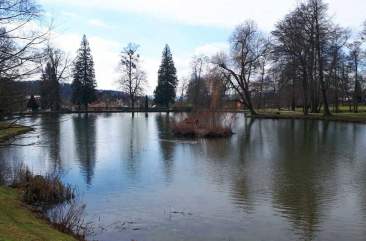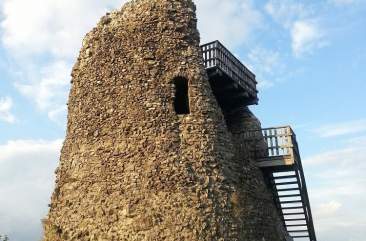Laboe Naval Memorial
of user Marinebund
- Suitable for kids
- Parking lots available
All information as overview
- Type
- Memorial
- Era
- Modernity
- Origin
- 1929
- City
- 24235 - Laboe
- send E-Mail
- Phone
- +49 4343 49484962
- Website
- to webpage
- Geo coordinates
- 54.412045, 10.231054
The history of the Naval Memorial is strongly connected with German history in the 20th century. Originally erected as a memorial for the German sailors killed in World War I, it has changed to an internationally accepted peace monument after World War II. It is maintained by the Deutscher Marinebund, the German Naval Association. The German Naval Association was founded in 1891 during the heydays of the German Imperial Navy as a naval veterans organisation. It was fiercly patriotic and thus Germanys defeat in World War I was a strong blow for the German Naval Association.
In 1926 Wilhelm Lammertz, a former petty officer in the German Navy and former chairman of the Marine Kameradschaft (Naval Club) Duisburg, came up with the idea to erect a memorial for the German sailors killed in the Great War.
His intention was to create a place of commemoration for those German sailors who had lost their life during the First World War and who's place of rest could not be decorated with tombstones and flowers. But it should not only be a place of mourning but also a token towards the future. The young generation should me made aware of the importance re-creating a strong German navy.
Lammertz' idea of a German Naval memoiral was quickly adopted by the Naval Association and after a architectural competition was decided in favour of a design by Professor Gustav August Munzer from Düsseldorf. The requirements specified were a monument of plain and simple form, which when seen from a distance would blend with the coastline yet be easily recognizable. Donations given by both, members of the Naval Association and those serving in the German Navy at that time. The project received no financial aid by the German government. As location for the new memorial the site of a recently disarmed coastal battery at Laboe was chosen. It proved to be an excellent position, since the monument is situated at the entrance of the Kiel fjord, near the locks of the Kiel Canal, a busy shipping route which carries most of the commercial sea traffic between the Baltic and the North Sea, respectively the Atlantic ocean.
The site of the German Naval Memorial provides a superb view to the open sea. Interpretations of the tower, rising to a height of 85 metres above sea level, range from the conning tower of a German submarine to a ships stem with rudder. The architects intention, however, as Prof. Munzer himself had pointed out, was to create a building resembling a rising flame, thus connecting the sea and the land with the sky. The foundation stone of the German Naval Memorial was laid an the 8th of August 1927 by Admiral Reinhard Scheer, commander-in-chief of the German High Sea Fleet during the battle of Jutland 1916 and then Honorary President of the Deutscher Marinebund.
Admiral Scheer dedicated the memorial to „Für deutsche Seemannsehr', für Deutschlands schwimmende Wehr, für beider Wiederkehr“, in English: “To German seamens honour, to Germanys floating arms, may both return.” Besides commemoration the hope of retaliation for the lost war spoke from this dedication, an interpretation that was later taken up by the Nazi regime.
After nine years of construction, the Naval Memorial was inaugurated on the 31st of May 1936, the day before the 20th anniversary of the battle of Jutland, with a grand ceremony and an act-of-state.
Adolf Hitler was also present but did not hold a speech. In his stead Generaladmiral Erich Raeder, Commander-in-Chief of the German navy, spoke. In his speech, Admiral Raeder interpreted the memorial according to national socialist ideology as a symbol of regained German naval power. Hitler, however, never came back to Laboe - he even despised the memorial as an “unparalled item of kitsch.”
The Naval Memorial survived World War II largely undamaged. After Germany's surrender in May 1945, the Marine-Ehrenmal was confiscated by the British occupation forces. However, it was not destroyed as other military memorials, being dedicated as a personal tribute to German naval war losses. As the British Military Administration stated, the memorial did not “glorify war and the spirit of aggression, but belongs to those whose intention is a personal tribute to the seamen who died for their country.”
The British re organisation board was by fortunate co incidence located in the same building as the current Social Secretary of the Deutscher Marinebund who was head of a law firm, with his legal guidance the Naval Memorial was returned to its former owners.
In 1954, the memorial was given back to the re-founded German Naval Association. During the restitution ceremony Otto Kretschmer, a famous Uboat commander during World War II and then president of the German Naval Association, dedicated the German Naval Memorial not only to the killed German sailors, but to all mariners who had lost their lives in both World Wars, including the allied war victims: “Dem Gedenken aller toten deutschen Seefahrer beider Weltkriege und unserer toten Gegner”, in English: “In commemoration of all dead German seamen and to our dead enemies”. Thus a new tradition of commemmoration was established,
interpreting the German Naval Memorial as a international peace memorial. Until this day, the DMB feels obliged to this commemorative tradition. To further underline and strenghten this commemorative tradition and to highlight the Naval Memorials role a international place of remembrace, the German Naval Association in 1996 decided to give it a new dedication: “Gedenkstätte für die auf See gebliebenen aller Nationen. Mahnmal für eine friedliche Seefahrt auf allen Meeren.” In English: “Memorial for all those who died at sea and for peaceful navigation in free waters.”
In the last decades, the Memorial has achieved international significance. In the Hall of Commemoration you will always find fresh flowers and wreaths, laid by German and foreign delegations or private groups or individuals. To this day, naval as well as merchant ships dip their flags on passing the Memorial in honour of all who died at sea.
In 1926 Wilhelm Lammertz, a former petty officer in the German Navy and former chairman of the Marine Kameradschaft (Naval Club) Duisburg, came up with the idea to erect a memorial for the German sailors killed in the Great War.
His intention was to create a place of commemoration for those German sailors who had lost their life during the First World War and who's place of rest could not be decorated with tombstones and flowers. But it should not only be a place of mourning but also a token towards the future. The young generation should me made aware of the importance re-creating a strong German navy.
Lammertz' idea of a German Naval memoiral was quickly adopted by the Naval Association and after a architectural competition was decided in favour of a design by Professor Gustav August Munzer from Düsseldorf. The requirements specified were a monument of plain and simple form, which when seen from a distance would blend with the coastline yet be easily recognizable. Donations given by both, members of the Naval Association and those serving in the German Navy at that time. The project received no financial aid by the German government. As location for the new memorial the site of a recently disarmed coastal battery at Laboe was chosen. It proved to be an excellent position, since the monument is situated at the entrance of the Kiel fjord, near the locks of the Kiel Canal, a busy shipping route which carries most of the commercial sea traffic between the Baltic and the North Sea, respectively the Atlantic ocean.
The site of the German Naval Memorial provides a superb view to the open sea. Interpretations of the tower, rising to a height of 85 metres above sea level, range from the conning tower of a German submarine to a ships stem with rudder. The architects intention, however, as Prof. Munzer himself had pointed out, was to create a building resembling a rising flame, thus connecting the sea and the land with the sky. The foundation stone of the German Naval Memorial was laid an the 8th of August 1927 by Admiral Reinhard Scheer, commander-in-chief of the German High Sea Fleet during the battle of Jutland 1916 and then Honorary President of the Deutscher Marinebund.
Admiral Scheer dedicated the memorial to „Für deutsche Seemannsehr', für Deutschlands schwimmende Wehr, für beider Wiederkehr“, in English: “To German seamens honour, to Germanys floating arms, may both return.” Besides commemoration the hope of retaliation for the lost war spoke from this dedication, an interpretation that was later taken up by the Nazi regime.
After nine years of construction, the Naval Memorial was inaugurated on the 31st of May 1936, the day before the 20th anniversary of the battle of Jutland, with a grand ceremony and an act-of-state.
Adolf Hitler was also present but did not hold a speech. In his stead Generaladmiral Erich Raeder, Commander-in-Chief of the German navy, spoke. In his speech, Admiral Raeder interpreted the memorial according to national socialist ideology as a symbol of regained German naval power. Hitler, however, never came back to Laboe - he even despised the memorial as an “unparalled item of kitsch.”
The Naval Memorial survived World War II largely undamaged. After Germany's surrender in May 1945, the Marine-Ehrenmal was confiscated by the British occupation forces. However, it was not destroyed as other military memorials, being dedicated as a personal tribute to German naval war losses. As the British Military Administration stated, the memorial did not “glorify war and the spirit of aggression, but belongs to those whose intention is a personal tribute to the seamen who died for their country.”
The British re organisation board was by fortunate co incidence located in the same building as the current Social Secretary of the Deutscher Marinebund who was head of a law firm, with his legal guidance the Naval Memorial was returned to its former owners.
In 1954, the memorial was given back to the re-founded German Naval Association. During the restitution ceremony Otto Kretschmer, a famous Uboat commander during World War II and then president of the German Naval Association, dedicated the German Naval Memorial not only to the killed German sailors, but to all mariners who had lost their lives in both World Wars, including the allied war victims: “Dem Gedenken aller toten deutschen Seefahrer beider Weltkriege und unserer toten Gegner”, in English: “In commemoration of all dead German seamen and to our dead enemies”. Thus a new tradition of commemmoration was established,
interpreting the German Naval Memorial as a international peace memorial. Until this day, the DMB feels obliged to this commemorative tradition. To further underline and strenghten this commemorative tradition and to highlight the Naval Memorials role a international place of remembrace, the German Naval Association in 1996 decided to give it a new dedication: “Gedenkstätte für die auf See gebliebenen aller Nationen. Mahnmal für eine friedliche Seefahrt auf allen Meeren.” In English: “Memorial for all those who died at sea and for peaceful navigation in free waters.”
In the last decades, the Memorial has achieved international significance. In the Hall of Commemoration you will always find fresh flowers and wreaths, laid by German and foreign delegations or private groups or individuals. To this day, naval as well as merchant ships dip their flags on passing the Memorial in honour of all who died at sea.
Visitor information
Business hours
01. November till 31. March daily
9:30am till 4:00pm
01. April till 31. Oktober daily
09:30am till 6:00pm
Prices
Adults 5,50 €
Pupils, Students, Soldiers 3,50 €
Youth (6-17 years) 3,50 €
Landmarks in the locality of Laboe Naval Memorial
More landmarks Zoo Gettorf4.012548 Page Loads | 3 Ratings
Zoo Gettorf4.012548 Page Loads | 3 Ratings Aquarium Kiel4.313821 Page Loads | 4 Ratings
Aquarium Kiel4.313821 Page Loads | 4 Ratings Manor House Borghorst0.05759 Page Loads | 0 Ratings
Manor House Borghorst0.05759 Page Loads | 0 Ratings Natural High Ropes Course Altenhof4.09713 Page Loads | 1 Rating
Natural High Ropes Course Altenhof4.09713 Page Loads | 1 Rating
Plan your route
Professor-Munzer-Ring 1
24235 Laboe
Germany
Start address:


_luftschutzbunker/001.jpg)









So far no comments have been written about this destination. Be the first and write a comment if you have already visited the destination.